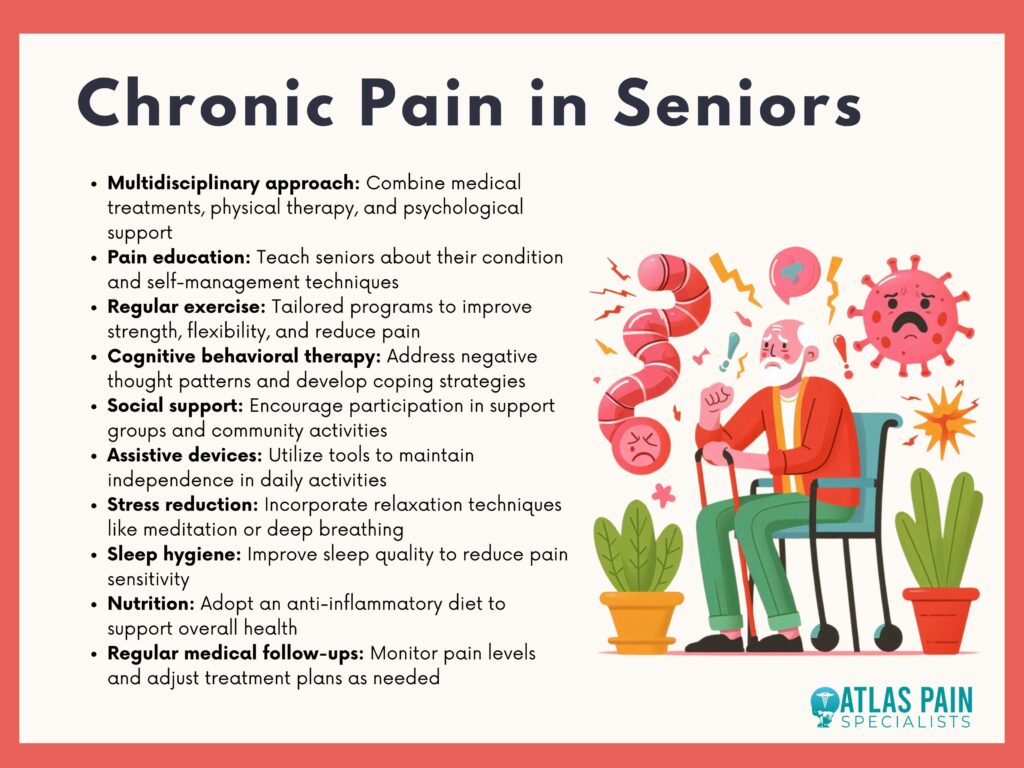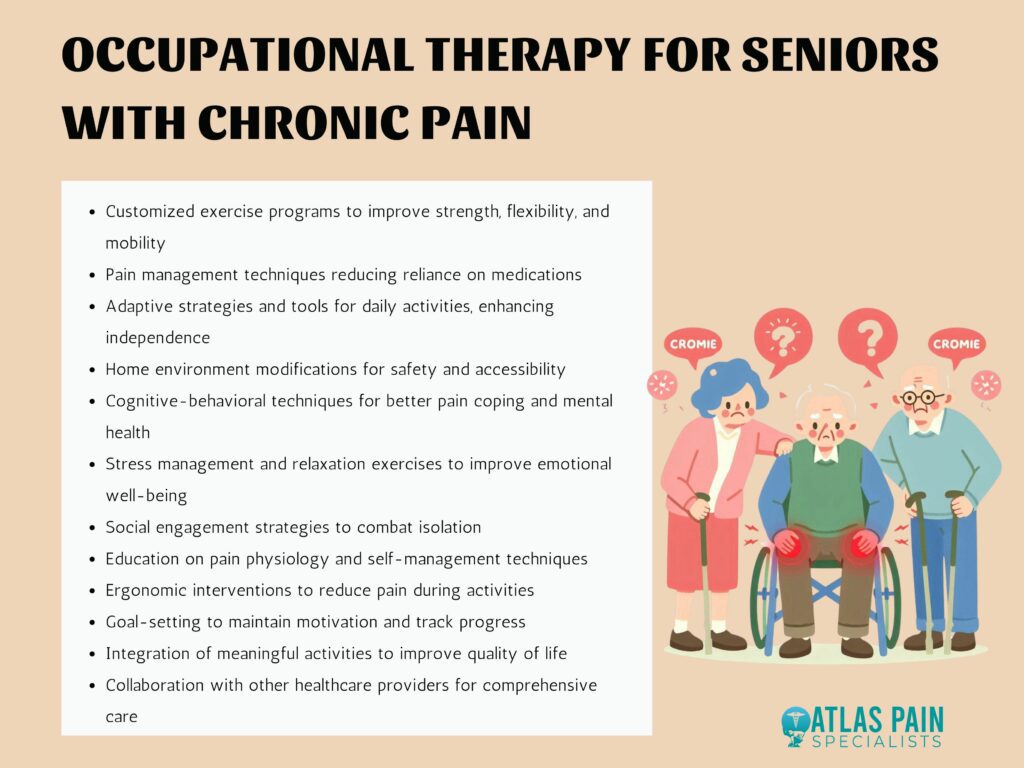

The Role of Occupational Therapy in Chronic Pain Management for Seniors
Chronic pain is a prevalent issue among seniors, significantly affecting their quality of life and ability to perform daily activities. Conditions such as arthritis, osteoporosis, and nerve damage are common culprits, leading to persistent discomfort that can last for months or even years.
Managing this pain is crucial not only for physical health but also for mental and emotional well-being. Effective pain management strategies are essential to help seniors maintain their independence and enjoy a higher quality of life.
When it comes to helping elders with chronic pain, occupational therapy is important. This type of therapy focuses on assisting patients in carrying out daily tasks that are important to them in spite of their discomfort. Let's look at the role of occupational therapy in chronic pain management for seniors.
Chronic Pain in Seniors
Chronic pain is defined as pain that persists for more than three months, often beyond the expected period of healing. It is a complex and multifaceted condition that can significantly impact the physical and emotional well-being of seniors.
Unlike acute pain, which serves as a warning signal for injury, chronic pain persists and can be a condition in itself, sometimes with no clear cause. For seniors, chronic pain can manifest in various forms, affecting different parts of the body and varying in intensity.

Causes and Contributing Factors
Seniors who have chronic pain might have a wide range of often complicated causes. Knowing them makes it easier to create focused treatments that deal with the underlying causes of the pain.
- Age-related changes in the body, such as the degeneration of joints and tissues.
- Underlying health conditions such as diabetes, which can lead to neuropathy, and cardiovascular diseases, which can cause ischemic pain.
- Past injuries, surgeries, and genetic predispositions.
- Lifestyle factors, such as physical inactivity and poor diet, can exacerbate pain conditions.
- Psychological factors, including depression and anxiety
The Impact of Chronic Pain on Daily Life and Overall Well-Being
Seniors with chronic pain may experience significant limitations in their everyday activities and a decline in their level of independence.
- Pain can make simple tasks, such as walking, dressing, and bathing, challenging and exhausting.
- Loss of function can lead to a decrease in social interactions and increased isolation, further affecting mental health and overall well-being.
- Chronic pain often leads to a cycle of decreased physical activity, which can worsen pain and lead to additional health problems.
- Persistent pain can lead to feelings of frustration, helplessness, and depression.
- It can cause sleep disturbances, which further exacerbate physical and emotional distress.
Despite chronic pain, seniors can keep their self-reliance and have a higher quality of life with comprehensive pain treatment strategies that include social, emotional, and physical help.
What is Occupational Therapy?
Occupational therapy is a client-centered health profession that focuses on promoting health and well-being through occupation. Occupations refer to the everyday activities that people engage in to occupy their time and bring meaning and purpose to their lives.
The principles of occupational therapy are grounded in the belief that engaging in meaningful activities is crucial for health and well-being. Therapists work to adapt to the environment, modify tasks, teach skills, and educate clients and their families to support participation in daily activities.
This can include anything from personal care and household chores to leisure activities and social participation.
How Occupational Therapy Helps Manage Chronic Pain in Seniors
For seniors dealing with chronic pain, occupational therapy aims to enhance their ability to perform daily tasks and maintain independence despite their pain. This therapeutic approach involves a holistic view of the individual's physical, emotional, and environmental needs.
1. Pain Management Techniques
Occupational therapy employs a variety of pain management techniques to help seniors cope with chronic pain.
- Physical exercises and movement strategies are tailored to the individual’s capabilities and pain levels.
These exercises are designed to improve strength, flexibility, and range of motion, which can help alleviate pain and enhance functional ability. Occupational therapists often teach patients how to perform these exercises safely and effectively, integrating them into daily routines.
- Use of adaptive equipment and modifications.
This can include tools like grab bars, ergonomic utensils, and specially designed furniture that reduce physical strain and make daily tasks easier to perform. Therapists may suggest environmental modifications, such as rearranging living spaces to minimize the need for painful movements or adjusting the height of work surfaces to prevent bending and reaching.
2. Coping Strategies and Mental Health Support
Chronic pain often has a significant emotional and psychological component, and occupational therapy addresses these aspects through various coping strategies and mental health support.
- Stress management techniques help seniors manage the anxiety and frustration that often accompany chronic pain.
- Techniques such as deep breathing exercises, progressive muscle relaxation, and guided imagery can be taught to reduce stress and promote relaxation.
- Cognitive-behavioral therapy (CBT) approaches are integrated into occupational therapy to help seniors change negative thought patterns and behaviors associated with chronic pain. Therapists work with patients to identify and challenge unhelpful thoughts, develop positive coping strategies, and set realistic goals.
- Relaxation techniques, including mindfulness and meditation, can be used to help seniors focus on the present moment and reduce the emotional impact of pain.
3. Assessment and Individualized Treatment Planning
Occupational therapists conduct comprehensive evaluations to understand the specific needs, challenges, and goals of each senior. This includes assessing physical abilities, pain levels, daily routines, and the impact of pain on various aspects of life.
Based on this assessment, therapists develop personalized treatment plans that address the unique circumstances of each individual. These treatment plans are dynamic and can be adjusted as needed to accommodate changes in the patient’s condition or progress.
The Role of the Occupational Therapist
Occupational therapy for chronic pain management focuses on helping individuals develop the skills and strategies needed to manage their pain effectively. This involves a combination of physical, cognitive, and emotional interventions designed to reduce pain, improve function, and enhance overall well-being.
1. Assessment and Individualized Treatment Planning
The process of assessment entails a detailed analysis of the person's physical capabilities, degree of pain, daily activities, and the ways in which pain affects different areas of their life. This way, therapists become better at customizing treatment regimens for each patient.
Occupational therapists create customized treatment plans that cater to the unique requirements and objectives of every elderly citizen, taking into account the results of their examination. These are dynamic designs that can be modified in response to changes in the patient's condition or advancement.
2. Collaboration with Other Healthcare Professionals
Occupational therapists often work as part of a multidisciplinary team to provide comprehensive care for seniors with chronic pain. This collaboration involves working closely with other healthcare professionals, such as doctors, physical therapists, and psychologists, to ensure a holistic approach to pain management.
Every team member contributes their area of expertise to the table, helping to create a comprehensive and successful treatment plan. All of the factors that contribute to chronic pain are taken into account and correctly addressed thanks to this team-based approach.
3. Educating Seniors and Their Families About Pain Management Strategies
Education is a fundamental aspect of the role of an occupational therapist in managing chronic pain. Therapists provide valuable information to seniors and their families about pain management techniques, the proper use of adaptive equipment, and strategies to reduce pain during daily activities.
Occupational therapists also educate families on how to support their loved ones effectively. This may include training on assisting with exercises, making necessary home modifications, and recognizing signs of increased pain or discomfort.
Occupational therapists foster a supportive environment that improves the efficacy of pain management techniques by teaching seniors and their families as well.
Benefits of Occupational Therapy for Seniors with Chronic Pain
In practice, the goals of occupational therapy may include improving physical function, enhancing cognitive abilities, promoting mental health, and supporting social participation. Therapists use a range of interventions tailored to the individual's specific circumstances, whether it's teaching new ways to perform daily tasks, recommending adaptive equipment, or providing strategies for managing pain and stress.

1. Improved Physical Function and Mobility
Chronic pain often leads to decreased activity levels, which can further exacerbate pain and lead to a decline in overall physical health. Exercise programs tailored to their specific needs and limitations focus on increasing strength, flexibility, and endurance.
Adaptive techniques and tools are also introduced to help seniors manage their pain while engaging in physical activities. Enhanced physical function and mobility not only reduce pain levels but also improve overall health and well-being, allowing seniors to enjoy a better quality of life.
2. Enhanced Quality of Life and Independence
Occupational therapy aims to enhance the overall quality of life for seniors by enabling them to perform meaningful activities despite chronic pain. This approach focuses on helping seniors maintain their independence, which is vital for their mental and emotional well-being.
Therapists also work on modifying the home environment to make it more accessible and safe for seniors with chronic pain. Simple changes, such as installing grab bars or rearranging furniture, can significantly reduce the risk of injury and make daily tasks more manageable.
3. Reduction in Pain Levels and Reliance on Pain Medication
Occupational therapy provides a holistic approach to managing chronic pain, focusing on non-pharmacological methods to reduce pain levels. Through various techniques such as physical exercises, adaptive equipment, and cognitive-behavioral strategies, occupational therapists help seniors manage their pain more effectively.
This often leads to a decreased reliance on pain medications, which can have numerous side effects and potential risks, especially for older adults. The reduction in pain levels achieved through these techniques not only improves physical comfort but also enhances overall health and well-being.
Seniors can experience fewer side effects from medications and enjoy a more active and engaged lifestyle.
4. Better Mental Health and Emotional Well-Being
Chronic pain can take a significant toll on mental health, leading to issues such as depression, anxiety, and social isolation. Occupational therapy addresses these emotional challenges by providing comprehensive mental health support alongside physical pain management.
Therapists work with seniors to develop effective coping strategies, including cognitive-behavioral techniques, relaxation exercises, and stress management practices. These interventions help seniors manage the psychological impact of chronic pain, improving their emotional resilience and overall mental health.
Improved mental health contributes to a higher quality of life, enabling seniors to maintain social connections and engage in activities that bring joy and fulfillment.
Benefits of Personalized Pain Management Plans
Occupational therapy offers a comprehensive and holistic approach to managing chronic pain in seniors, addressing both the physical and emotional aspects of this complex condition. Occupational therapists help seniors regain their independence, increase their physical function, and improve their overall quality of life by focusing on customized therapy regimens.
Personalized plans are the cornerstone of effective pain management, as they cater to the unique needs and circumstances of each individual. These plans ensure that the interventions are tailored to the specific type of pain, physical capabilities, and personal goals of the senior, making the therapy more effective and meaningful.
They are essential for improving physical function and mobility, as tailored exercises and adaptive techniques can be more precisely aligned with the senior's needs. Personalized plans contribute to better mental health by incorporating coping strategies and support systems that resonate with the senior's experiences and challenges.
About Dr. Sean Ormond



